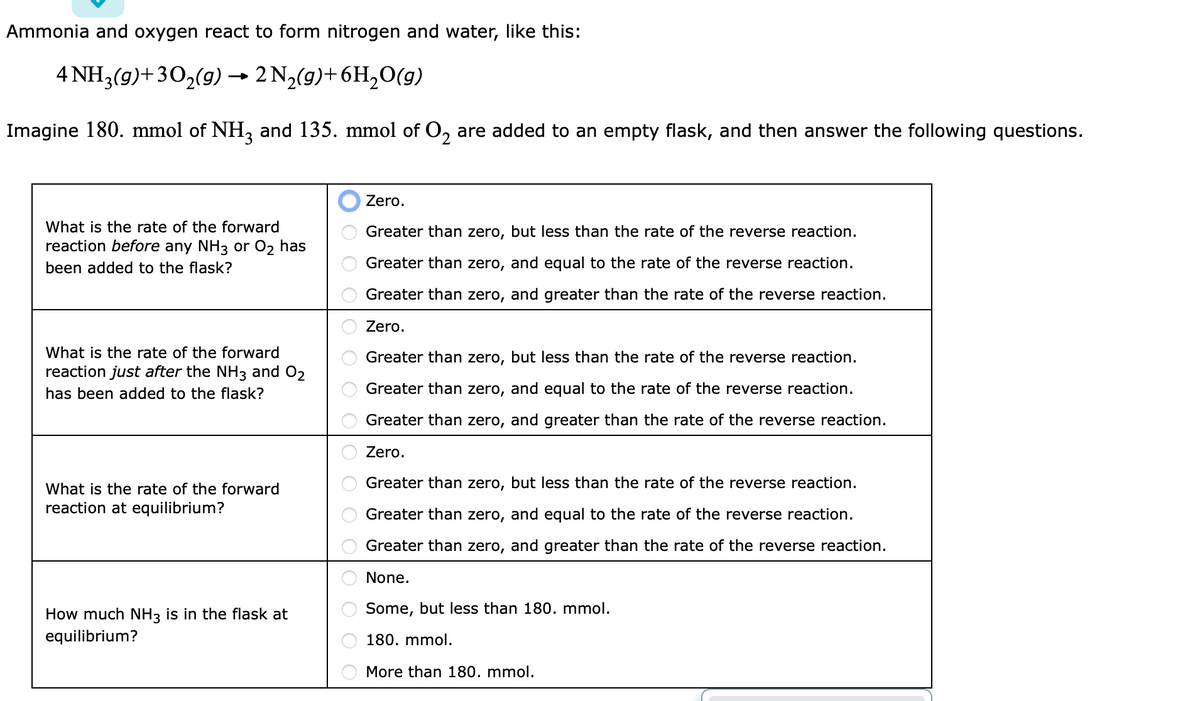Ammonia and oxygen react to form nitrogen and water, like this: 4 NH3(g)+30₂(g) ► 2N₂(g) + 6H₂O(g) Imagine 180. mmol of NH3 and 135. mmol of O₂ are added to an empty flask, and then answer the following questions. What is the rate of the forward reaction before any NH3 or O₂ has been added to the flask? What is the rate of the forward reaction just after the NH3 and O₂ has been added to the flask? What is the rate of the forward reaction at equilibrium? How much NH3 is in the flask at equilibrium? Zero. O Greater than zero, but less than the rate of the reverse reaction. O Greater than zero, and equal to the rate of the reverse reaction. O Greater than zero, and greater than the rate of the reverse reaction. O Zero. O Greater than zero, but less than the rate of the reverse reaction. O Greater than zero, and equal to the rate of the reverse reaction. O Greater than zero, and greater than the rate of the reverse reaction. O Zero. O Greater than zero, but less than the rate of the reverse reaction. O Greater than zero, and equal to the rate of the reverse reaction. O Greater than zero, and greater than the rate of the reverse reaction. O None. O Some, but less than 180. mmol. 180. mmol. More than 180. mmol.
Ammonia and oxygen react to form nitrogen and water, like this: 4 NH3(g)+30₂(g) ► 2N₂(g) + 6H₂O(g) Imagine 180. mmol of NH3 and 135. mmol of O₂ are added to an empty flask, and then answer the following questions. What is the rate of the forward reaction before any NH3 or O₂ has been added to the flask? What is the rate of the forward reaction just after the NH3 and O₂ has been added to the flask? What is the rate of the forward reaction at equilibrium? How much NH3 is in the flask at equilibrium? Zero. O Greater than zero, but less than the rate of the reverse reaction. O Greater than zero, and equal to the rate of the reverse reaction. O Greater than zero, and greater than the rate of the reverse reaction. O Zero. O Greater than zero, but less than the rate of the reverse reaction. O Greater than zero, and equal to the rate of the reverse reaction. O Greater than zero, and greater than the rate of the reverse reaction. O Zero. O Greater than zero, but less than the rate of the reverse reaction. O Greater than zero, and equal to the rate of the reverse reaction. O Greater than zero, and greater than the rate of the reverse reaction. O None. O Some, but less than 180. mmol. 180. mmol. More than 180. mmol.
Chemistry: The Molecular Science
5th Edition
ISBN:9781285199047
Author:John W. Moore, Conrad L. Stanitski
Publisher:John W. Moore, Conrad L. Stanitski
Chapter8: Properties Of Gases
Section: Chapter Questions
Problem 30QRT
Related questions
Question

Transcribed Image Text:Ammonia and oxygen react to form nitrogen and water, like this:
4 NH3(g)+30₂(g) → 2 N₂(g) + 6H₂O(g)
Imagine 180. mmol of NH3 and 135. mmol of O₂ are added to an empty flask, and then answer the following questions.
What is the rate of the forward
reaction before any NH3 or 0₂ has
been added to the flask?
What is the rate of the forward
reaction just after the NH3 and 02
has been added to the flask?
What is the rate of the forward
reaction at equilibrium?
How much NH3 is in the flask at
equilibrium?
ο οίο ο Ο
O
Zero.
Greater than zero, but less than the rate of the reverse reaction.
Greater than zero, and equal to the rate of the reverse reaction.
Greater than zero, and greater than the rate of the reverse reaction.
Zero.
Greater than zero, but less than the rate of the reverse reaction.
Greater than zero, and equal to the rate of the reverse reaction.
Greater than zero, and greater than the rate of the reverse reaction.
Zero.
Greater than zero,
but less than the rate of the reverse reaction.
Greater than zero, and equal to the rate of the reverse reaction.
Greater than zero, and greater than the rate of the reverse reaction.
None.
Some, but less than 180. mmol.
180. mmol.
More than 180. mmol.
Expert Solution
This question has been solved!
Explore an expertly crafted, step-by-step solution for a thorough understanding of key concepts.
Step by step
Solved in 4 steps

Knowledge Booster
Learn more about
Need a deep-dive on the concept behind this application? Look no further. Learn more about this topic, chemistry and related others by exploring similar questions and additional content below.Recommended textbooks for you

Chemistry: The Molecular Science
Chemistry
ISBN:
9781285199047
Author:
John W. Moore, Conrad L. Stanitski
Publisher:
Cengage Learning

Chemistry
Chemistry
ISBN:
9781305957404
Author:
Steven S. Zumdahl, Susan A. Zumdahl, Donald J. DeCoste
Publisher:
Cengage Learning

Chemistry: An Atoms First Approach
Chemistry
ISBN:
9781305079243
Author:
Steven S. Zumdahl, Susan A. Zumdahl
Publisher:
Cengage Learning

Chemistry: The Molecular Science
Chemistry
ISBN:
9781285199047
Author:
John W. Moore, Conrad L. Stanitski
Publisher:
Cengage Learning

Chemistry
Chemistry
ISBN:
9781305957404
Author:
Steven S. Zumdahl, Susan A. Zumdahl, Donald J. DeCoste
Publisher:
Cengage Learning

Chemistry: An Atoms First Approach
Chemistry
ISBN:
9781305079243
Author:
Steven S. Zumdahl, Susan A. Zumdahl
Publisher:
Cengage Learning


Chemistry by OpenStax (2015-05-04)
Chemistry
ISBN:
9781938168390
Author:
Klaus Theopold, Richard H Langley, Paul Flowers, William R. Robinson, Mark Blaser
Publisher:
OpenStax